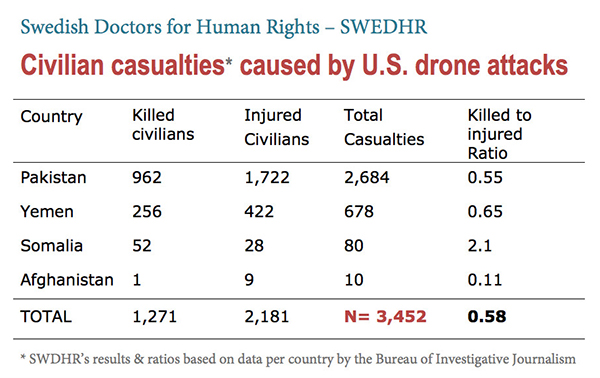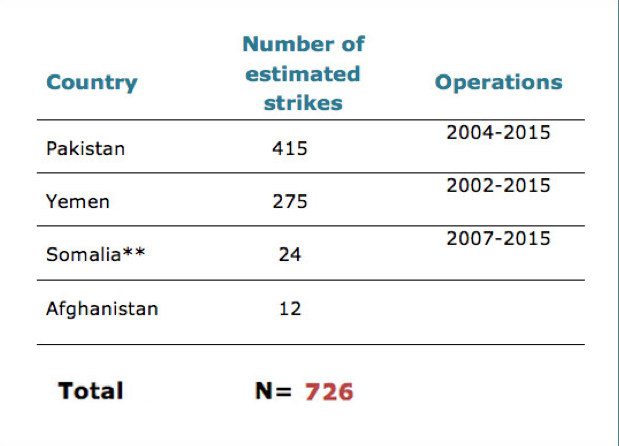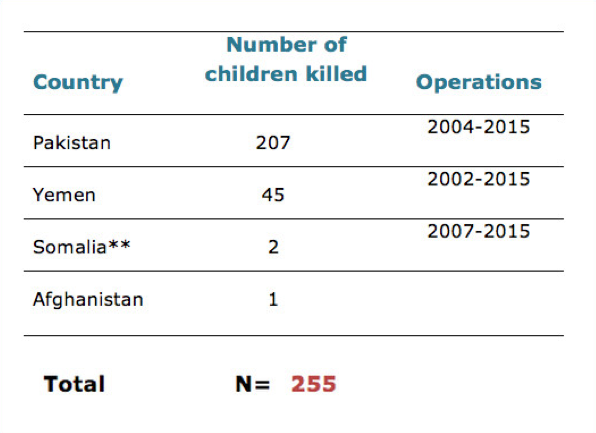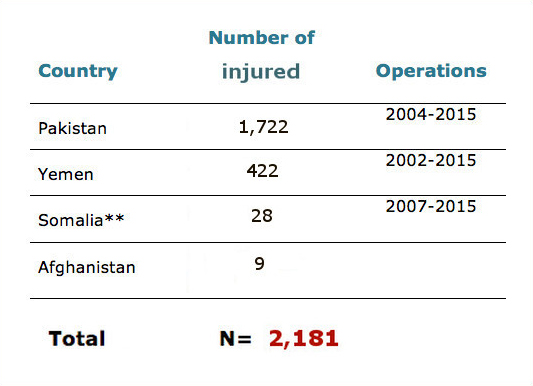
The International Committee of the Red Cross establishes clearly in Rule 7 of “Customary International Humanitarian Law”: [1] “The parties of the conflict must at all times distinguish between civilian objects and military objectives. Attacks may only be directed against military objectives. Attacks must not be directed against civilian objects.”
By Prof. Marcello Ferrada de Noli, Prof. Marita Troye-Blomberg, Prof. Anders Romelsjö, Dr Leif Elinder, and Dr Martin Gelin, from Swedish Doctors for Human Rights | Photos: own works and SU.se | This article was first published at SDHR | Updated 19:49 on April 25, 2015
But among the civilian victims of drone attacks are not only those forming part of local population collaterally damaged: It has been revealed 23 of April 2015 by several international news outlets, i.e. The New York Times [1], Wall Street Journal, or [2], Huffington Post [3], that drones strikes have killed American, European hostages amidst a number of civilians’ victims in an attack on January 2015.
Now, even The Voice of America, a newspaper not known for its criticism to White House policies, runs today the headline, “Killing of Hostages Calls US Drone Policy Into Question”. [4]
Research issues
While conducting research in the subject injury epidemiology at the Karolinska Institutet, Ferrada de Noli et al. (2008) concluded [1] that the actual number of fatalities in war-related events, such as combats or air strikes in the U.S. occupation war in Iraq, were significantly higher than those reported in the “body counting” sites, also used as sources by the media.
Concretely, a report presented at the international Injury Research conferences in Vienna, respectively Prague in 20014, noted that the figures presented by the media did not include injured individuals that died after been transported as wounded to other localities, such as hospitals or camps. These demises can occur even long afterwards the event causing the wounds, namely the combats or air strikes such as bombing or drone-targeting hits. In other words, media reports refer as a rule to only fatalities that perished in situ and at that very occasion.
The findings, which were later replicated and further developed in a Karolinska Institutet’s Master thesis [2], referred the following epidemiological problematic leading to an underestimation in the assessing of casualties:
- A particular epidemiological confounding may occur when the variables of the study are ill-defined or the conceptual extension of the entities under study is used in a too broad meaning.
- One example is if we assign to ”casualties” both fatalities and injured victims and in the third part analysis the toll is read as only fatalities ipso facto at the time of the referred armed clash or combat.
Now, if the above estimating-problem is huge referred to regular military personnel reported as fatalities, it is just logical to conclude that such bias is higher prevalent when referred to civilian populations victims of drone-strikes. This, partly because of the areas targeted commonly correspond a) to countries with poorer hospital facilities or epidemiological administrative services, b) to areas populated mostly by poor people, that due to SEC-factors would have lesser possibilities to have their peers’ fatalities (long time after the injury-event) reported.
We argue that a similar situation occurs with the multiple reports in the international Human Rights community trying to assess the impact of drone-strikes amidst the civilian population. The reports refer partly to civil casualties derives from drone-attacks, and partly to the physical collateral damage in the humble infrastructures and habitat of the victims.
On the other hand, the wider the number of reports, the more imprecise is growing the epidemiological estimate of drone-related fatalities or drone-related injuries at all. Also, important media outlets and blog reports have focused on this issue.

The counting of civil casualties caused by US drone strikes
Table 1 reports only fatality cases. Hence, they do not include
- a) Victims that died long time afterwards, as a sequelae of injuries received at the strike; b) victims as the result of fatal events reported as ”likely caused by drone-strike”; and c) fatalities reported as drone-strike related but that correspond to other so-called cover operations. We have made a calculation base in peak estimates. [8]
Table 2 presents the total number of confirmed strikes up to date. These figures are a “meta-estimate”, meaning that it corresponds to calculations we made based on the base of a variety of sources available (See Sources down below).
Table 3 reports the total number of confirmed civilians that have been wounded in drone strikes.
Data based in updates [9] (Pakistan), [10] (Yemen), [11] Somalia, and [12] Afghanistan, by the Bureau of Investigative Journalism and other sources.
Summary:
Total number of confirmed U.S.-drone strikes, N= 473
Total number of estimated fatal casualties among civilians, N= 1271
Total number of fatal casualties among Children, N= 255
Total number of injured, N= 2.181
Summary Table:

Tables per casualty category and country:
Table 1. Civilian fatalities

* Includes possible extra drone-strikes and other cover operations
** Includes other cover operations
Table 2. Number of drone strikes, cover operations

Table 3. Children killed

Table 4. Injured

Fatalities to injured ratio
The ratio killed/injured among civilians was found to be 0.58
Discussion
Our meta-estimates were sourced predominantly in the counting per country made by the Bureau of Investigative Journalism, from were we extracted data only in regards to civil casualties. In the calculation of total number of civil casualties regarding the four countries listed (Pakistan, Yemen, Somalia, and Afghanistan), we used the highest estimations given in the range [8].
In our results, it is worth to remark the relatively high lethality ratio killed/injured among the civilian casualties (Ratio= 0.58), which would indicate low expectation for survival among the civil population hit by modern drone strikes. As a reference for comparison, we calculated the fatalities to injured ratio considering all German casualties during the Allied aerial bombing in WWI, which resulted in only 0.38 [16].
The tactical usefulness of drones strikes are also questioned by a finding mentioned in a Guardian’s article [17] reporting that in the drone strikes at Pakistan and Yemen “only 12 % of victims were identified as militants”.
Finally, in the context of on-going allegations from the US and EU countries regarding fabricated “Russian attacks”, it is highly suitable to mention that while U.S. drones have killed over 1,200 civilians in countries of Asia and the middle East, Russia’s drones have killed 0 civilians, in no place in the world whatsoever.
By Prof. Marcello Ferrada de Noli, Prof. Marita Troye-Blomberg, Prof. Anders Romelsjö, Dr Leif Elinder, and Dr Martin Gelin, from Swedish Doctors for Human Rights
References ad notes
[1] Jean-Marie Henckaerts & Louise Doswald-Beck, “International Committee of the Red Cross, Customary International Humanitarian Law. Volumen I, Rules”. Cambridge University Press, 2009,
[2] The New York Times, “Drone Strikes Reveal Uncomfortable Truth: U.S. Is Often Unsure About Who Will Die“. 23 April 2015.
[3] Huffington Post, “A Drone Program That Has Killed Hundreds Of Civilians Finally Killed Some That The White House Regrets”. 23 April 2015.
[4] Wall Street Journal. “American, Italian Hostages Killed in CIA Drone Strike in January“. 23 April 2015.
[5] The Voice of America, “Killing of Hostages Calls US Drone Policy Into Question”. 23 April 2015.
[6] M Ferrada de Noli, I A John, L Svanström (2004): Epidemiological Bias In Assessments Of War-Related Injuries: The Case Of Iraq. Safety 2004. P. 230 Institut Leben/Kuratorium fur Schutz und Sicherheit, Vienna, Austria. Referred in http://www.docstoc.com/docs/84208837/KIbroschyr-vers2pmd
[7] “Epidemiological Bias in Assessment of War-Related Injuries During Iraq War Between 20th March 2003 To 20th March 2004“. Thesis. By Ime Akpan John, MD, PhD. Supervisor Prof. Marcello Ferrada de Noli. Department of Social Medicine, Karolinska Institutet, 2005.
[8] The Bureau of Investigative Journalism, “Casualty Estimates”. In “Get the data: Drone wars”, retrieved 23 April 2015.
[9] The Bureau of Investigative Journalism, “CIA drone strikes in Pakistan, 2004 to present”. Datasheet. Retrieved 23 April 2015.
[10] Jack Serle, “Yemen: Reported US covert actions 2015”. Bureau of Investigative Journalism, 26 January 2015.
[11] Bureau of Investigative Journalism’s Drones Team, “Somalia: reported US covert actions 2001-2015”
[12] Jack Serle, “Get the data: A list of US air and drone strikes, Afghanistan 2015”. Bureau of Investigative Journalism, 12 February 2015.
[13] Figures on allies’ air raids on Germany Jul-Oct 1918 sourced at U.K. National Archives (AIR 1/1918/204/232/): 740 killed and 1,900 wounded.
[14] Trevor Tim, “The hostages killed by US drones are the casualties of an inhumane policy“. The Guardian, 24 April 2015. The Guardian figures was sourced in the Bureau of Investigative Journalism.
[16] Figures on allies’ air raids on Germany Jul-Oct 1918 sourced at U.K. National Archives (AIR 1/1918/204/232/): 740 killed and 1,900 wounded.
[17] Trevor Tim, “The hostages killed by US drones are the casualties of an inhumane policy“. The Guardian, 24 April 2015. The Guardian figures was sourced in the Bureau of Investigative Journalism.
Human Rights organizations sources
Amnesty: Amnesty International & Human Rights Watch Release Dual Reports on Drone Strikes
Open Society Foundations: Death by Drone – Civilian Harm Caused by U.S. Targeted Killings in Yemen (PDF)
Media sources
Washington Post: Drone strikes killing more civilians than U.S. admits, human rights groups say
New York Times: Civilian Deaths in Drone Strikes Cited in Report
Research analysis and media-investigative reports
The Bureau of Investigative Journalism: Get the data: Drone wars
The Bureau of Investigative Journalism: Covert Drone War
Living under Drones: Numbers
New Republic: Drone Strikes Kill Innocent People. Why Is It So Hard to Know How Many?

 NewsVoice är en nättidning för oberoende nyheter, debatt och analys.
NewsVoice är en nättidning för oberoende nyheter, debatt och analys. 
